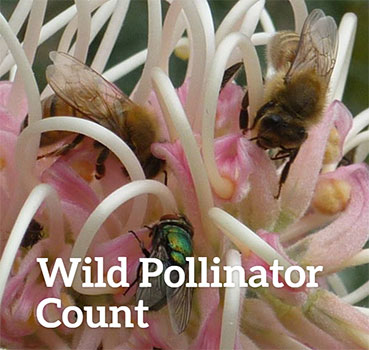Backyard beekeepers' gathering
/Backyard beekeepers catch up and chat in Thurgoona, Wed 18th February 2015.
All welcome!
Karen Retra: notes of a neighbourhood naturalist in Albury, Australia. Particularly native bees, nature and garden.
Backyard beekeepers catch up and chat in Thurgoona, Wed 18th February 2015.
All welcome!
Looking for an excuse to spend ten minutes observing the pollinators in your garden or nearby? Of course you are!
I'm sure you know that as well as European honeybees, there are loads of other pollinators. Not just my personal favorites (native bees!) but also all sorts of beetles, flies, butterflies and more. And relatively little is known about them.
Dr Manu Saunders, an ecologist at Charles Sturt Uni, and I have teamed up to create a pollinator observation project. We hope to gather some data about local pollinators as well as trial this approach. We'd love you to get involved.

The concept is simple - on a sunny day, sometime in the week of November 9th to 15th, spend ten minutes watching some flowers. Then share your observations of the pollinators you see on our project website - www.wildpollinatorcount.wordpress.com.
You can do just one ten-minute count, or do a few. You might observe in the same or different spots, or on different flowers, during the week. We've even made a printable tally sheet, to help you keep track. Or you can flex your own record-keeping skills to gather your data (c'mon, I'm not the only one who loves a challenge that involves recording details, surely!?).
There are lots of resources and photos on the website to help you identify the insects you see - and even if you're not sure of the identification, you can record the details you did notice. You can also upload photos, if you wish.
We are focussing the count on Albury/Wodonga, but would love to have contributions from North East Victoria and Southern NSW too, so please pass this on to anyone you think may be interested in participating.
As this is the first time we are running it, we also welcome any positive or negative feedback about the project and/or ideas as to how we might improve on it in future!
For more information please visit the Wild Pollinator Countwebsite. Go on - give it a crack!
I thoroughly enjoyed the recent Woomargama Bioblitz event. You might be familiar with the Bioblitz concept – surveying an area for plants and animals and recording what is found. When you’ve got experts along to help, as they did in Woomargama, it’s a fantastic opportunity to improve your own knowledge as well as see things you might not otherwise notice or be able to identify. The data from this Bioblitz was uploaded into the national biodiversity aggregator, the Atlas of Living Australia. With so little known about so many of our Australian species, surveys such as this are invaluable for adding to our collective knowledge.
But did you also know you don’t have to be an expert to make a contribution?
A new website developed by Museum Victoria, BowerBird.org.au, offers us all the chance to have our sightings of flora and fauna identified by experts and potentially added to the Atlas of Living Australia.
Here’s how it works. After creating a free account, you can upload photos, a description and the location of what you’ve seen. You can identify the species yourself if you know. Or ask for assistance from the many experts involved with the site.
I uploaded some photos of native bees I took at an event at Wirraminna in Burrumbuttock. I tried to get close and took shots from various angles to provide much detail as possible for identification. A camera with macro is great, but even my pictures taken with my phone sufficed.
Dr Ken Walker from Museum Victoria identified the bees as Leioproctus versicolor on BowerBird and encouraged me to add other sightings. You bet!

Image: a screen shot from the BowerBird site of my submission and Dr Ken Walker's response.
Projects are another feature of the site. A project can be a place or an event, where everyone can add and view sightings. So ‘Nail Can Hill’ might be a project. Other users have set up projects of their backyards and schools, and yes, even Bioblitz events.
You can also ‘follow’ particular people, organisations or projects on BowerBird, so that you see the content that interests you most. You won’t be surprised to hear I’m following the ‘Australian bees’ project.
Want to know more? Dr Ken Walker will be presenting a series of ‘talks, walks and gawks’ in our area between November 5th and 7th, including sessions about the BowerBird website. For details see here.
An edited version of this article appeared in the Living Lightly column of the Border Mail and online on Saturday 26th October.
Karen Retra. A neighbourhood naturalist, home gardener and native bee tragic.

Hi, I'm Karen ... a neighbourhood naturalist, home gardener and native bee tragic. Read more
Like to receive new posts
by email?
Content on this site is subject to a Creative Commons license - CC BY-NC-SA-3.0.
If in doubt, please contact me to request the use of my material.